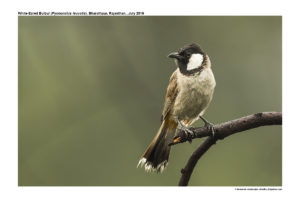
White-eared Bulbul Pycnonotus leucotis
Etymology:
- Pycnonotus : Greek word puknos thick, compact; notos –backed { thick backed}
- Leucotis: Greek word leukos white; otis –eared { White eared}
Vernacular Names: Sind: Bhooroo, Hindi: Safed kaan bulbul, Sans: Shwet-karna bulbul, Kash: Bil-bi-chur, H.P.: Painju, Pun: Pahari bulbul, Kushandra, Ben: Kundghara, Pahari bulbul, Lepcha: Manglio-kur, Mankliphkur, Nepal: Jureli, Guj: Kanara bulbul, Kachchi bulbul, Ran bulbul, Kutch: Jogido, Mar: Safed/ Pandhrya gallacha bulbul
Distribution in India: Resident in North West India
Description: Size of 17·5–19 cm; wt. of 18–28 g. It is a medium-sized, lively, conspicuous bulbul, virtually uncrested. It has a black head and throat, with large white patch on side of head; upperparts are relatively pale grey, becoming even paler on rump; breast also relatively pale, hardly darker than lower underparts. Its vent and undertail-coverts are bright orange-yellow; iris is dark brown or hazel, pale bare eyering dull greyish to dull yellowish; bill is blackish-horn; legs are bluish-grey to slaty black. Both the sexes are similar. The juvenile has brown replacing black on head, and paler body, wings and tail, paler yellow undertail-coverts
Habitat: It is found in dry woodland, thorn-scrub, semi-desert scrubs, riverine shrubbery, mangroves, palm groves, gardens, agricultural land and orchards. Sometimes frequents tall reedbeds, especially when roosting.
Food Habits: It feeds on fruits, petals of flowers, nectar, insects and occasionally insects. It Often descends to the ground in quick sallies, or hops around for more extended periods, to feed on insects, seeds and other items; probes flowers to feed on nectar, or on the insects gathered there. Flying ants and termites often caught in short, clumsy aerial sallies.
Breeding Habits: They breed in Apr–Jul in Iraq and Jul–Sept in India. The mating display includes spreading and fluttering of wings and tail by male, and fanning of bright vent plumage. The nest is a simple but firmly built cup-shaped structure, composed of fine twigs, rootlets, grass and other plant fibers, sometimes unlined, usually neatly lined with slender fibers. Both the partners visit nest-site together during building phase, but only one (female) brings material, suggesting that male mate-guards female during fertile period. They lay a clutch of 2–4 eggs. The incubation is done by female. The incubation period is 13–14 days .The chicks are fed by both sexes. The nestling period is 9–11 days.